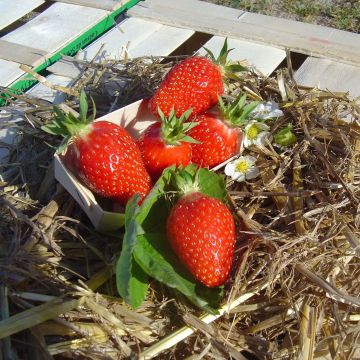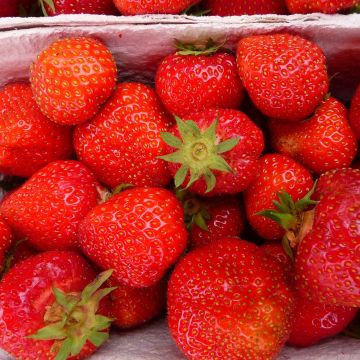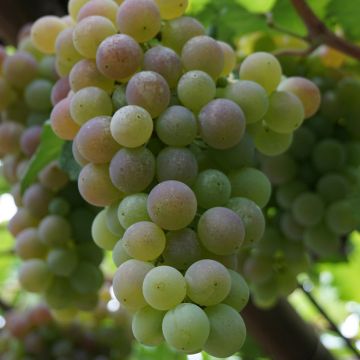

Fragaria vesca 'Baron Solemacher'
Fragaria vesca Baron Solemacher
Wild Strawberry, Woodland Strawberry, Alpine Strawberry, European Strawberry
This item cannot be shipped to the selected country
Dispatch by letter from €3.90
More information
Schedule delivery date,
and select date in basket
This plant carries a 6 months recovery warranty
More information
We guarantee the quality of our plants for a full growing cycle, and will replace at our expense any plant that fails to recover under normal climatic and planting conditions.
Seed-only orders are dispatched by sealed envelope. The delivery charge for seed-only orders is €3.90.
Description
The 'Baron Solemacher' Strawberry is a woodland strawberry native to Germany, whose fruit, larger than that of the typical woodland strawberry, is oblong in shape with prominent seeds. This cultivar, created in 1935, is perpetual, offering continuous flowering from early spring until the end of summer. It is a delight to pick and consume the fruits directly from the plant, as their flavor is delicate and aromatic. This is sure to excite children!
The flowers charmingly dot the edges of vegetable garden pathways, balconies, and patios. The harvest begins in late spring and continues until the first frost. This variety does not produce any runners and only propagates through sowing.
The strawberry is a perennial plant belonging to the Rosaceae family. Known throughout Europe since ancient times, it naturally grows in all the undergrowth of temperate regions. However, most of the juicy strawberries cultivated in our gardens are hybrids derived from a species native to Chile, brought back by the navigator Amédé François Frézier. There are indeed several species of strawberries, the main ones being: Fragaria vesca, or Woodland Strawberry, known for producing particularly aromatic small fruits; Fragaria moschata, or Musk Strawberry; Fragaria viridis, or Green Strawberry - also known as Valley Strawberry - less desirable due to the acidity of its fruits; and finally, Fragaria chiloensis, or Chilean Strawberry. These are wild strawberries. The large-fruited strawberries cultivated today are mostly derived from Fragaria x ananassa species, which originated from Fragaria chiloensis and another American species, Fragaria virginiana.
The strawberry has a spreading habit that can reach 40cm (16in) in width and height. The evergreen leaves are trifoliate, obovate, with well-toothed edges, and form dark green rosettes. Its flowering is characterized by a multitude of small white, yellow, or pink flowers with golden hearts. Then, depending on the varieties, they produce mostly red fruits, but recent cultivars offer pink, yellow, or white strawberries. Botanically speaking, strawberries are considered pseudocarps, with the achenes (seeds) protruding from the epidermis.
The flavour of the strawberry is very delicate and is characterized by a sweet and fruity aroma, sometimes with a slight tangy note in the background. We can distinguish non-perpetual varieties that flower only once a year in spring from perpetual varieties that flower twice a year or continuously from spring to autumn. Strawberries are a fruit rich in vitamins B8 and B9, very rich in vitamins C and E, and provitamin A. They are known for their remineralizing, hypotensive, and purifying properties. It is worth noting that they can cause skin irritation for some people, as they stimulate the release of histamine in the body.
Harvesting: pick the fruits as they ripen on the plants. Strawberries are delicate, so pick them with their peduncle by pinching the stem 1 to 2cm (0 to 1in) above it. The texture of the fruit is a good indicator of its ripeness. It should be firm and yield slightly to pressure.
Storage: strawberries are best consumed fresh, either on their own, with cream, or as a topping for tarts. They can be stored for about a week in the vegetable drawer of your refrigerator. When they have been bruised or scratched, they will not keep as long. If you have a large harvest, keep in mind that strawberries are delicate fruits. To extend their shelf life, consider using sugar, the best friend of fruits. Naturally, you can make jams, marmalades, compotes, or syrups. Of course, you can also make ice cream or sorbet, but they will not keep as long. Another option is to dry the strawberries in the oven, slicing them into thin slices of at least 1mm, which can be added to your muesli. Finally, strawberries freeze very well. Small containers for freezing are now available for small fruits like strawberries, raspberries, or currants, etc.
Gardener's tip: strawberry plants are good companions for garlic, beans, lettuce, onions, leeks, thyme, and spinach. However, they do not appreciate the company of cabbage and other brassicas.
Report an error about the product description
Harvest
Plant habit
Foliage
Botanical data
Fragaria
vesca
Baron Solemacher
Rosaceae
Wild Strawberry, Woodland Strawberry, Alpine Strawberry, European Strawberry
Western Europe
Perennial
Other Strawberry plants
Planting and care
The strawberry plant is admirable for its hardiness and ease of cultivation. It thrives in all types of soil, adapts to partial shade but prefers full sun while tolerating short periods of drought. As it readily multiplies through runners, be careful not to let it spread too much.
Before starting the sowing, you can place your seeds in the freezer compartment of your refrigerator for a few days and then in the vegetable drawer. Indeed, this will facilitate germination after a period that can be compared to winter and the gradual warming of spring.
Greenhouse sowing: sow from February to May in a warm environment (16 to 18°C (60.8 to 64.4°F)) in a tray with one-third special seed compost, one-third garden soil, and one-third sand. Cover with a layer of compost 1 to 2mm thick, then lightly firm. Water and make sure to keep the substrate moist. Strawberry plants take some time to emerge. Patience is required because after about 35 days, the first seedlings will appear. When the plants have 5 to 6 leaves, transplant them into pots where they will continue to grow comfortably until they can be planted in the ground.
Transplanting in the ground: once the risk of frost is gone, usually after the Ice Saints in mid-May, and your plants have several leaves, transplant them into the ground. Dig a hole in the soil. If you plan to plant multiple plants, space them 35cm (14in) apart in all directions. Depending on the variety, you may have to wait before the first fruiting.
Maintenance: regularly weed. It is beneficial to mulch your strawberry plants to maintain moisture and prevent the fruits from touching the ground, thus protecting them from grey rot.
Seedlings
Care
Intended location
-
, onOrder confirmed
Reply from on Promesse de fleurs
Berries
Haven't found what you were looking for?
Hardiness is the lowest winter temperature a plant can endure without suffering serious damage or even dying. However, hardiness is affected by location (a sheltered area, such as a patio), protection (winter cover) and soil type (hardiness is improved by well-drained soil).

Photo Sharing Terms & Conditions
In order to encourage gardeners to interact and share their experiences, Promesse de fleurs offers various media enabling content to be uploaded onto its Site - in particular via the ‘Photo sharing’ module.
The User agrees to refrain from:
- Posting any content that is illegal, prejudicial, insulting, racist, inciteful to hatred, revisionist, contrary to public decency, that infringes on privacy or on the privacy rights of third parties, in particular the publicity rights of persons and goods, intellectual property rights, or the right to privacy.
- Submitting content on behalf of a third party;
- Impersonate the identity of a third party and/or publish any personal information about a third party;
In general, the User undertakes to refrain from any unethical behaviour.
All Content (in particular text, comments, files, images, photos, videos, creative works, etc.), which may be subject to property or intellectual property rights, image or other private rights, shall remain the property of the User, subject to the limited rights granted by the terms of the licence granted by Promesse de fleurs as stated below. Users are at liberty to publish or not to publish such Content on the Site, notably via the ‘Photo Sharing’ facility, and accept that this Content shall be made public and freely accessible, notably on the Internet.
Users further acknowledge, undertake to have ,and guarantee that they hold all necessary rights and permissions to publish such material on the Site, in particular with regard to the legislation in force pertaining to any privacy, property, intellectual property, image, or contractual rights, or rights of any other nature. By publishing such Content on the Site, Users acknowledge accepting full liability as publishers of the Content within the meaning of the law, and grant Promesse de fleurs, free of charge, an inclusive, worldwide licence for the said Content for the entire duration of its publication, including all reproduction, representation, up/downloading, displaying, performing, transmission, and storage rights.
Users also grant permission for their name to be linked to the Content and accept that this link may not always be made available.
By engaging in posting material, Users consent to their Content becoming automatically accessible on the Internet, in particular on other sites and/or blogs and/or web pages of the Promesse de fleurs site, including in particular social pages and the Promesse de fleurs catalogue.
Users may secure the removal of entrusted content free of charge by issuing a simple request via our contact form.
The flowering period indicated on our website applies to countries and regions located in USDA zone 8 (France, the United Kingdom, Ireland, the Netherlands, etc.)
It will vary according to where you live:
- In zones 9 to 10 (Italy, Spain, Greece, etc.), flowering will occur about 2 to 4 weeks earlier.
- In zones 6 to 7 (Germany, Poland, Slovenia, and lower mountainous regions), flowering will be delayed by 2 to 3 weeks.
- In zone 5 (Central Europe, Scandinavia), blooming will be delayed by 3 to 5 weeks.
In temperate climates, pruning of spring-flowering shrubs (forsythia, spireas, etc.) should be done just after flowering.
Pruning of summer-flowering shrubs (Indian Lilac, Perovskia, etc.) can be done in winter or spring.
In cold regions as well as with frost-sensitive plants, avoid pruning too early when severe frosts may still occur.
The planting period indicated on our website applies to countries and regions located in USDA zone 8 (France, United Kingdom, Ireland, Netherlands).
It will vary according to where you live:
- In Mediterranean zones (Marseille, Madrid, Milan, etc.), autumn and winter are the best planting periods.
- In continental zones (Strasbourg, Munich, Vienna, etc.), delay planting by 2 to 3 weeks in spring and bring it forward by 2 to 4 weeks in autumn.
- In mountainous regions (the Alps, Pyrenees, Carpathians, etc.), it is best to plant in late spring (May-June) or late summer (August-September).
The harvesting period indicated on our website applies to countries and regions in USDA zone 8 (France, England, Ireland, the Netherlands).
In colder areas (Scandinavia, Poland, Austria...) fruit and vegetable harvests are likely to be delayed by 3-4 weeks.
In warmer areas (Italy, Spain, Greece, etc.), harvesting will probably take place earlier, depending on weather conditions.
The sowing periods indicated on our website apply to countries and regions within USDA Zone 8 (France, UK, Ireland, Netherlands).
In colder areas (Scandinavia, Poland, Austria...), delay any outdoor sowing by 3-4 weeks, or sow under glass.
In warmer climes (Italy, Spain, Greece, etc.), bring outdoor sowing forward by a few weeks.





















































